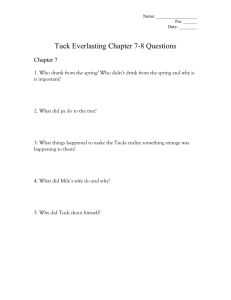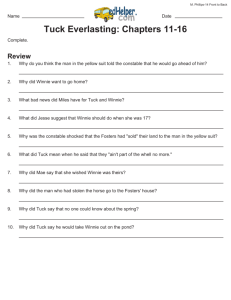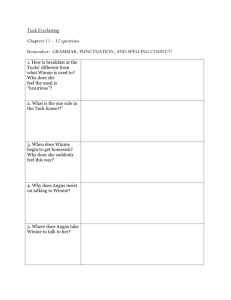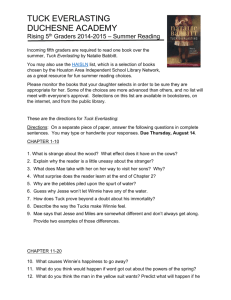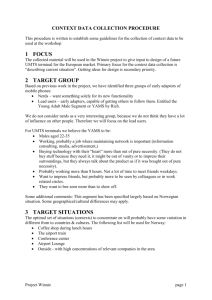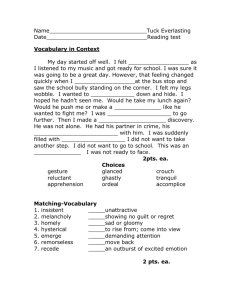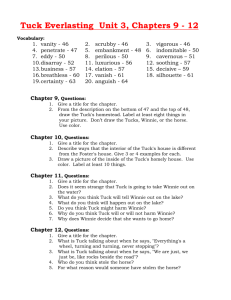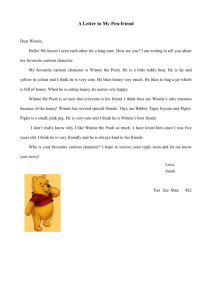Be able to match these words with the corresponding information
advertisement
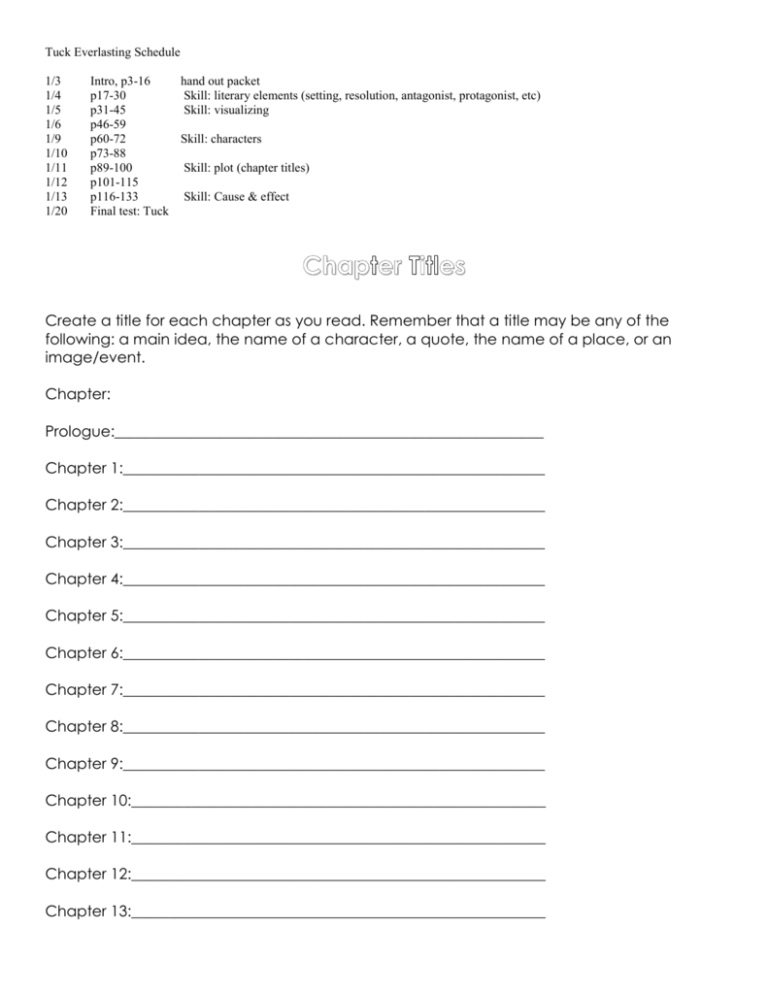
Tuck Everlasting Schedule 1/3 1/4 1/5 1/6 1/9 1/10 1/11 1/12 1/13 1/20 Intro, p3-16 hand out packet p17-30 Skill: literary elements (setting, resolution, antagonist, protagonist, etc) p31-45 Skill: visualizing p46-59 p60-72 Skill: characters p73-88 p89-100 Skill: plot (chapter titles) p101-115 p116-133 Skill: Cause & effect Final test: Tuck Chapter Titles Create a title for each chapter as you read. Remember that a title may be any of the following: a main idea, the name of a character, a quote, the name of a place, or an image/event. Chapter: Prologue:_________________________________________________________ Chapter 1:________________________________________________________ Chapter 2:________________________________________________________ Chapter 3:________________________________________________________ Chapter 4:________________________________________________________ Chapter 5:________________________________________________________ Chapter 6:________________________________________________________ Chapter 7:________________________________________________________ Chapter 8:________________________________________________________ Chapter 9:________________________________________________________ Chapter 10:_______________________________________________________ Chapter 11:_______________________________________________________ Chapter 12:_______________________________________________________ Chapter 13:_______________________________________________________ Chapter 14:_______________________________________________________ Chapter 15:_______________________________________________________ Chapter 16:_______________________________________________________ Chapter 17:_______________________________________________________ Chapter 18:_______________________________________________________ Chapter 19:_______________________________________________________ Chapter 20:_______________________________________________________ Chapter 21:_______________________________________________________ Chapter 22:_______________________________________________________ Chapter 23:_______________________________________________________ Chapter 24:_______________________________________________________ Chapter 25:_______________________________________________________ Epilogue:_________________________________________________________ Tangent a sudden change of course bovine relating to a cow or ox oppressive treating in a harsh and unfair way meager thin, small, scanty, sparse accessible easy to get or reach conceal to hide immense of great size or quantity melancholy sad or gloomy rueful pitiful, sad, regretful intrusion forced entry grimace twisting and tightening of the facial muscles peered stared marionette a puppet that has strings twilight when the sun is below the horizon, but light is still visible retorted debated; replied to an argument with the opposite opinion remnants the small part left over of something reluctantly not willingly disheartened discouraged timid easily scared; shy instinct a natural talent or ability protest show dislike or objection to something or someone plaintive showing sorrow or sadness Accomplice assistant to a crime Anguish extreme pain or sorrow Arc curved path Axis straight line around which something rotates Contemplation process of thinking something through Ebb decrease in force or level Fragrant sweet-smelling Helter-skelter without order, messy Immense very large Implore beg Impulse sudden act Indefinitely for an unlimited time Pickle difficult situation Ponderous of great weight Primply stiffly, daintily Pry pull by using a lever Profoundly deeply Rave talk wildly Recede move backward, withdraw Soothing comforting Teeming filled to overflowing Venture bold or risky act Counting on Characters Below is a list of important characters from Tuck Everlasting. You should write down important pieces of information about each character, such as: characteristics, appearance, relationships with other characters, feelings, actions, character traits, how they change throughout the novel, etc. Keeping good notes here will help you study and keep your from becoming confused by all of the different characters we encounter in the novel. Include at least 8 pieces of information for the following individuals: Tuck Family, Mae Tuck, Angus Tuck, Winnie Foster, Man in the Yellow Suit, Jesse Tuck, and Miles Tuck. Include at least 2 pieces of information for the following individuals: Foster Family, Toad, Granny Foster, Mrs. Foster, Constable, and Mr. Foster. Character Tuck Family Mae Tuck Angus Tuck Winnie Foster Man in the Yellow Suit Description Jesse Tuck Miles Tuck Foster Family Toad Granny Foster Mrs. Foster Constable Mr. Foster Word Tranquil Infinite Abruptly Rueful Meager Melancholy Exasperated Irrelevant Scornful Vigorous Peculiar Vanity Disarray Elation Silhouettes Definition Sentence with Context Clues & page Visualization Gestured Anguish Lingered Gallows Persisted Immense Fatal Clenched Sprawled Babbling Gingerly Parched Revulsion Remorseless Accomplice • In what ways can life be seen as a cycle or wheel? • What is the purpose of death in the world of living things? Big • What are some ways that people grow and change as they experience the different stages of life? Theme Questions • How might living forever be both a blessing and a curse? • How can the certainty of death influence the way we choose to live our lives? Prologue • List the words and phrases Babbitt uses to describe the first week in August. • How does the author create a feeling of suspense in the prologue? Write down a few questions the prologue raised in your mind. Chapter 1 •Draw the first house, the road, and the wood in Treegap as you picture them after reading Chapter 1. Use colors if you'd like, and label or explain as needed. Chapter 2 •Make a character map of Mae Tuck. •How are Angus's and Mae's personalities different? How can you tell? •What questions does this chapter raise in your mind? Chapter 3 •How does Winnie feel about her life? •Describe a time when you had feelings similar to Winnie's or thought about running away. •Make a character map of Winnie. Chapter 4 •For whom or what do you think the man in the yellow suit is searching? •How do you feel about the man in the yellow suit? What sensory details make you feel this way? •Predict one or two events that might happen next in the story. Chapter 5 •How does Winnie respond to Jesse? What do you think of him? •What do you think Mae Tuck means when she says, "The worst is happening at last"? •List the questions that formed in your mind at the end of this chapter. Chapter 6 •Describe the many different emotions felt by the Tucks and by Winnie at this point in the story. •Do you sympathize with the Tucks' feelings? Why or why not? •Can you relate to Winnie's feelings? Why or why not? •How do Winnie's visions of what it would be like to be kidnapped compare with her actual experience? Chapter 7 •What do you think about the Tucks' story? Support your thinking with examples from the book. •If you were Winnie, would you believe their story? Why or why not? •Summarize what has happened to the Tucks since they drank from the spring. •List some parts of Chapter 7 that are fantasy and others that are realistic. Chapter 8 &9 •Summarize the different feelings Mae, Jesse, and Miles Tuck have about living forever. •How does Winnie feel about her life and about the Tucks now? What is one of the major ways in which Winnie has changed? Give evidence from the story. Chapter 10 & 11 •Compare and contrast Winnie's home and the Tucks' home. What key words describe Winnie's home and the Tucks' cottage? •Draw a picture of a room in the Tucks' cottage, based on details in the text. •What feelings does Winnie experience as she tours the cottage and eats dinner with the Tucks? Chapter 12 & 13 •What familiar or recurring images appear in Chapters 12 and 13? Where in the book have these images been described before? •How are these recurring images related to the theme of the story? •Describe the central theme of the story in your own words. •Do you think the wheel is a good symbol for life? Why or why not? •What does Tuck mean by the statement "You can't have living without dying"? Chapter 14 & 15 •Discuss the characters' different perspectives. Why do other characters' differing perspectives create confusion for Winnie? •How are Winnie's feelings toward the Tucks changing? Chapter 16 & 17 •Identify any recurring images in today's reading and discuss what themes or ideas the images suggest. •When fishing with Miles, why does Winnie kill a mosquito but ask Miles to let the trout go free? •Describe Winnie's feelings toward the Tucks now. Chapter 18 & 19 •Why does Mae react so strongly to the stranger's plan, and how does this scene mark a turning point for Winnie? Chapter 20 & 21 •Why is Mae in danger? Support your answer. •Winnie recognizes that she is different when she returns home. How has Winnie changed? Show proof for your answer. (You could create a before-and-after Venn diagram for this.) •What does it mean to grow up? Are there parts of growing up that are "satisfying and lonely, both at once," as Winnie describes? Explain. Chapter 22 & 23 •Create a story graph for Tuck Everlasting. •Identify any recurring images and explain what they suggest. •How do the author's descriptions of the weather add drama and emphasize a change in Winnie? Chapter 24 •Write about responsibility and obeying the law. What are some variations and exceptions? In what ways is Winnie facing these issues?. •What vivid words and phrases does the author use in Chapter 24? Do these details make the chapter more interesting or exciting? Why? •"Stone walls do not a prison make, / Nor iron bars a cage." How does this relate to the story? Chapter 25 •Predict whether or not Winnie will choose to drink the spring water when she is seventeen years old.. •If you were in Winnie's place, would you drink the spring water? Give reasons for your answer. •Note any recurring images and what they suggest. Epilogue •List details from the epilogue that show time has passed since the last time the Tucks were in Treegap.. •Why does Tuck say "Good girl" when he sees Winnie's gravestone? Be able to match these words with the corresponding information from Tuck Everlasting. Describe the literary elements found in Tuck Everlasting. We will discuss what these elements are (mean) in class. 1. setting - ________________________________________________________________ 2. resolution - ________________________________________________________________ 3. antagonist - ________________________________________________________________ 4. protagonist - ________________________________________________________________ 5. theme – ________________________________________________________________ 6. internal conflict – ______________________________________________________________ 7. external conflict – _____________________________________________________________ 8. foreshadowing – ______________________________________________________________ 9. symbols – ________________________________________________________________ Be able to put events from the story in order. a. ___ Angus finds Winnie’s gravestone in the cemetery. b. ___ Mae hits the stranger with the shotgun and he dies. c. ___ Winnie pours her water on the toad. d. ___ Winnie tells the toad that she wants to do something important. e. ___ Winnie helps Mae escape from jail. f. ___ Jesse meets Winnie at the gate and they plan an escape for Mae. g. ___ The constable takes Winnie home and puts Mae in jail. h. ___ Winnie wants to run away. She then meets Jesse Tuck in the woods and is curious about the spring. i. ___ Tuck takes Winnie on the pond to explain about the cycle of life. Events - Answer the following questions: a. Which month is at the top of the “live-long” year? Where does the author place this month on the Ferris wheel of time on a year? b. When Winnie threw pebbles at the toad, what did she tell him she wanted to do? c. When Winnie was first taken away by the Tucks, what helped to calm her down? d. How did the Tucks know that it was the spring water that caused them to stop changing? e. What event helped the Tuck’s realize that the spring water is what caused their condition? f. Describe the differences between the Tuck’s house and Winnie’s house. What do the descriptions of each family’s house tell us about the characteristics of that family? g. Why did Tuck take Winnie on the pond? h. How did the man in the yellow suit find Winnie? i. Compare and contrast Jessie’s and Miles’ perspectives on life after drinking from the spring. j. What did the man in the yellow suit want from the Fosters in exchange for Winnie? k. What plan did the man in the yellow suit have for the water, the Tucks, and finally Winnie? l. What does Mae do that surprises everyone? m. Why was Tuck envious of the man in the yellow suit as he lay on the ground? n. How did the constable know that Mae should be arrested? o. What helped the escape plan work? p. What did Winnie do with the water Jesse gave her? q. Why does Mae state in the epilogue that they have no reason to come back to Treegap? r. How did Winnie’s family and the Tucks speak to Winnie differently? Be specific. Essay Writing - On your OWN SHEET OF PAPER, write a good paragraph for each of TWO of the following questions: A. In what ways can life be seen as a cycle or wheel? Were the Tucks on this wheel? Why or why not? B. What is the purpose of death in the world of living things? What examples did Angus Tuck give to Winnie? Why were the Tucks no longer part of the cycle of life? C. List and describe two of the many symbols in Tuck Everlasting. What do they represent? How do they explain what is happening in the story? D. How does the weather change and what does it mean in the story? How do the author’s descriptions of the weather add drama and emphasize a change in Winnie? E. Explain what the lines from an old poem (p. 123) mean, “Stone walls do not a prison make, Nor iron bars a cage.” F. Describe how Winnie changed over the course of those four days. G. State and explain three of the themes of the story. Use details from the story to support your thoughts.
